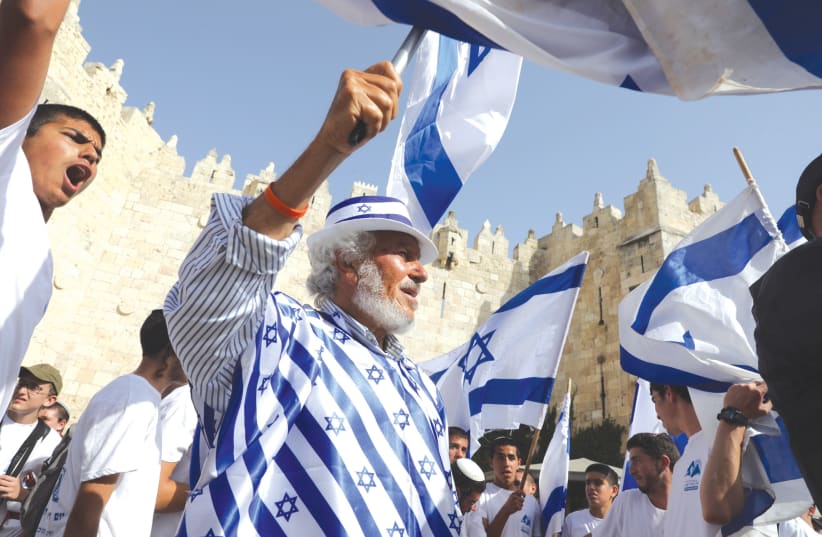No parade in history was more jubilant, liberating or inspiring than what Jerusalem saw 55 years ago this weekend.
Having just emerged from the bomb shelters where most of them spent the previous week, and having been told the previous day that the Old City’s gates will be opened that morning, 200,000 Israelis flocked to Mount Zion and jointly walked toward the Western Wall, which most of them had never seen.
Having been there as a kid, I will never forget that day, nor would anyone else who was there – a multitude of Jews of all backgrounds, many singing spontaneously, some also dancing, and all feeling the catharsis which so swiftly undid the previous weeks’ uncertainty and fears.
It was Shavuot, and it took no historian, archaeologist, or poet to wonder whether that was how ancient Israel’s pilgrimages sounded and felt.
It was also pretty much the opposite of most other parades, which are organized rather than spontaneous, usually also orchestrated, and in some cases even choreographed.
Brazil’s seemingly chaotic carnival, for instance, actually involves many months’ preparations, and for some of its dancers also lengthy training.
That is certainly the case with New York’s annual Thanksgiving Day parade, and its colorful collection along the years of filmic-characters’ larger-than-life balloons, from Mighty Mouse and Popeye to Bugs Bunny and Shrek.
While their organizers never purported to produce anything as meaningful as a biblical pilgrimage, these parades still inspire genuine joy, whether of Americans expressing their happiness to be Americans, or of Brazilians happy to momentarily escape the rest of the year’s hardships.
This doesn’t mean all parades are happy.
Parades of hatred and fear
SOME PARADES were designed not to make people happy, but to vent hatred and instill fear.
Such were the Brown Shirts parades across prewar Germany. The torches they carried, the drums they beat, and the slogans they hollered were designed to make millions shiver, as they indeed did.
This was also the intention of the American Nazis who back in the mid-1970s planned to march through Chicago suburb Skokie. The marches were blocked by court rulings, but the neighborhood was selected deliberately because it had a sizable Jewish community, including many Holocaust survivors.
Fortunately, the parade Jerusalem saw last Sunday is not a version of those unhappy parades. It does, however, bring to mind Northern Ireland’s Orange marches.
Commemorating William of Orange’s defeat of King James II, the last Catholic monarch of England, Ireland and Scotland, these band-led parades have been held for centuries, and their participants are not Nazis, but unarmed Protestants wearing bowler hats and orange collarets, who are out to express their religious and national identity.
The Orangemen, as they are known, are in their own eyes innocent patriots, and even their opponents concede that many of them indeed are. Even so, many Irish Catholics, and also Protestant Scots, have seen in the Orange parades celebrations of nationalist triumphalism, political defiance and sectarian provocation.
During the violent decades that ended with the 1998 Good Friday Agreement, marches that passed through Catholic areas triggered much verbal abuse and at times also physical violence. In 1972 there were also fatalities.
This is where our own Jerusalem Day is now approaching.
THE INNOCENT jamboree on Shavuot of 1967 has morphed over the past half-century into an entirely different creature.
Last Sunday’s Jerusalem Day parade included a multitude’s passage within predominantly Arab streets while singing “let your village burn down,” and also chanting “death to the Arabs.” Peppered with attacks on Arab passersby, stoning of cars and assaults on television crews, this part of the current Jerusalem Day is dismissed by organizers as the lot of “a straying handful,” which of course is no consolation to its targets, and in any event leaves its perpetrators well within the dictionary definition of fascists.
Yet even if most of the Jerusalem Day marchers are not fascists, they refuse to realize that they are but a local version of Northern Ireland’s Orange marchers.
Jerusalem’s spontaneous parade in 1967 was the antithesis of sectarianism. It was not about humiliating, displacing or even just defeating another nation. Instead, it was about Jewish self-help and creation. That is why all Jews were there, if not physically then mentally. But then came controversy, as the war’s conquests produced the territorial debate which, 55 years on, still haunts Israeli society.
The debate is legitimate, but some of its participants have become frustrated with history’s refusal to dance to their tune. Most notable among these is messianic Zionism, whose theorists believe the Jewish state’s emergence is part of God’s plan to move the Jews from the Diaspora to the Land of Israel, and from secularism in all its forms to Orthodox observance.
The victory of 1967 gave this theory’s believers a sense of epiphany. However, the subsequent encounter with the Palestinians, and the persistence of Israeli secularism, exposed this theory’s naiveté. That is what frustrates this part of Israeli society, and that is what its leaders cannot explain.
Nothing demonstrates this frustration more rudely than what messianic Zionists have made of Jerusalem Day.
Refusing to realize they are not the patriotic avant-garde they think they are, but just another tile in Israel’s sectarian mosaic, they barge into the world’s most explosive powder keg dancing with big flags, singing songs most Israelis don’t know, and segregating men and women, in a country where women head banks, universities and courts. Deluding themselves that they are leading the rest of Israel, they in fact were followed through the Old City’s gates by no one except the La Familia soccer-fan club’s bigots.
The question about them is therefore this. When will messianic Zionism stage its grand retreat: before or after the fire it is playing with rages through the disjointed city that Middle Israelis love no less than them, maybe more?
www.MiddleIsrael.net
The writer’s bestselling Mitzad Ha’ivelet Ha’yehudi (The Jewish March of Folly, Yediot Sefarim, 2019), is a revisionist history of the Jewish people’s leadership from antiquity to modernity.

